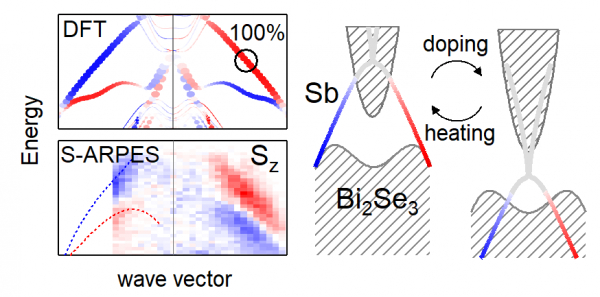Topological insulators are a class of materials with high spin-orbit coupling and non-trivial band topology, having topological surface states (TSSs) that are protected by time-reversal symmetry. These TSSs are fully spin-polarized with a predominant in-plane spin orientation near the Fermi level dictated by the symmetry of the spin-momentum locking.
A new range of spintronic effects and related applications would become available if TSSs with out-of-plane spin texture could be designed. For instance, out-of-plane spin transfer torques are expected to reverse more efficiently than in-plane ones the magnetization of layers with perpendicular magnetic anisotropy, which are usually employed in logic and memory devices.
In our joint spin- and angle-resolved photoemission spectroscopy and density functional theory study we show that a hetero-structure built of antimonene, i.e. a single layer of buckled antimony, and a prototypical topological insulator, Bi2Se3, has a TSS with a nearly full out-of-plane spin polarization within the substrate’s bulk band gap. We demonstrate the possibility to finely and reversibly tune the degree of spin polarization within the substrate’s gap. We explain the origin of this unusually high out-of-plane spin polarization as related to a symmetry-protected band crossing, and predict that similar phenomena may occur in a class of hetero-structures comprising antimonene and topological insulators.
For info: Polina Sheverdyaeva


 English (UK)
English (UK)  Italiano (Italia)
Italiano (Italia)